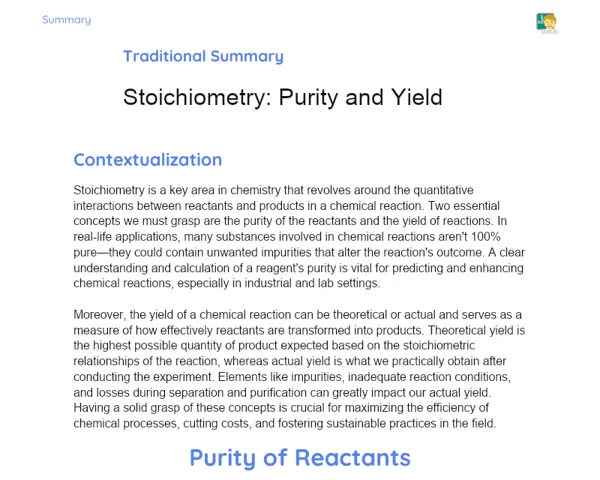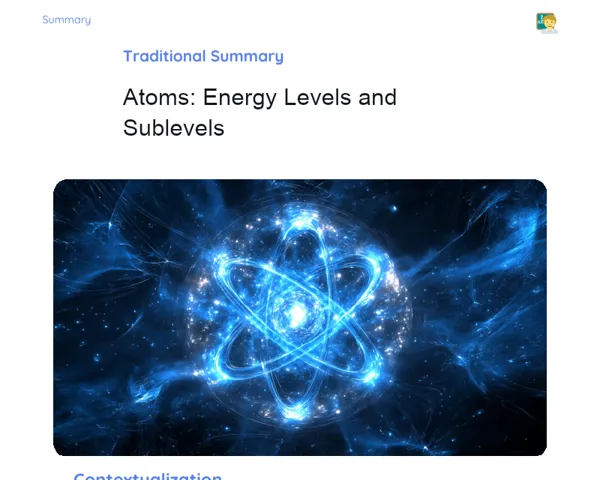Objectives
1. 🎯 Grasp the differences between isotopes, isobars, and isotones by identifying their unique characteristics.
2. 🎯 Use knowledge of isotopes, isobars, and isotones in real-world scenarios, such as dating artefacts and medical diagnostics.
3. 🎯 Enhance critical thinking skills by examining how these subatomic particles interact and their implications in chemistry and beyond.
Contextualization
Did you know that isotopes are vital in dating historical artefacts and even play a role in nuclear medicine? For instance, Carbon-14, an isotope of carbon, helps determine the age of fossils and ancient bones through carbon dating, which is crucial for archaeologists and paleontologists everywhere. Furthermore, radioactive isotopes are commonly utilized in medical diagnostics and targeted treatments. Appreciating these distinctions and their real-life uses is essential to understand how chemistry shapes our insights into both history and current practices.
Important Topics
Isotopes
Isotopes are different versions of a chemical element that have the same atomic number but different mass numbers due to varying neutron counts. This leads to differences in physical properties and, in some cases, chemical properties.
-
A well-known example is Carbon-14, which is used for archaeological dating. It has 6 protons and 8 neutrons, resulting in a mass number of 14.
-
Radioactive isotopes, like Cesium-137, are vital in nuclear medicine and radiotherapy, thanks to their specific radioactive decay patterns.
-
Grasping the concept of isotopes is essential for environmental chemistry, as it aids in monitoring pollution sources and the fate of chemical elements in nature.
Isobars
Isobars are atoms from different elements that have the same mass number but different atomic numbers and neutron counts. They allow comparisons of physical and chemical properties between diverse elements.
-
Carbon-14 and Nitrogen-14 are classic examples, both possessing a mass number of 14 yet differing in atomic numbers and distinct chemical properties.
-
Studying isobars is important for comprehending nuclear stability and how chemical elements are formed during nuclear reactions in stars and supernovae.
-
Isobars are instrumental in mass spectrometry, aiding in the precise identification of elements within unknown samples.
Isotones
Isotones are atoms that share the same number of neutrons but have varying atomic and mass numbers. These elements may exhibit similar physical and chemical traits yet belong to different elements.
-
Sodium Fluoride (NaF) and Oxygen-19 are examples of isotones; both have 10 neutrons but differ in atomic and mass numbers.
-
Exploring isotones is critical for understanding how different elements can exhibit similar biological and chemical roles in both biological and environmental contexts.
-
Isotones are useful in dating techniques, such as fissile trace dating, which relies on the presence of isotones in minerals.
Key Terms
-
Isotope: Variants of an element with the same number of protons yet different numbers of neutrons.
-
Isobar: Atoms of differing elements that share the same mass number but have distinct atomic numbers.
-
Isotone: Atoms from different elements that have an identical number of neutrons while differing in atomic numbers.
For Reflection
-
How has our understanding of isotopes, isobars, and isotones contributed to advancements in modern technology and scientific practices?
-
In what ways can knowledge of isotopes assist in tackling environmental issues, such as tracking pollutants or managing nuclear waste?
-
What is the significance of distinguishing isotopes, isobars, and isotones for safety in fields involving radiation, like nuclear medicine and the energy sector?
Important Conclusions
-
In our exploration of atoms and their variations, we delved into the concepts of isotopes, isobars, and isotones, grasping their structures, distinctions, and practical uses.
-
We recognized their importance not just in chemistry, but also in areas like archaeology, medicine, and environmental science, underscoring the interconnectedness of scientific fields.
-
Being able to differentiate and apply knowledge concerning isotopes, isobars, and isotones is foundational in solving complex global issues, from dating fossils to treating illnesses.
To Exercise Knowledge
- Build Your Own Atomic Model: Use materials like clay or cardboard to model atoms for various isotopes. 2. Practical Isotope Research: Pick an element with multiple isotopes and explore its applications, such as in healthcare or industry. 3. Isotope Dating Simulation: Use an online simulator to learn how scientists date historical materials with isotopes, and then prepare a report on your experiment and outcomes.
Challenge
🔍 Atomic Detective Challenge: Picture yourself as a scientist detective tasked with solving a mystery using isotopes. Craft a scenario where isotope dating can play a pivotal role in cracking the case. Detail how you would use isotopes and present your conclusions based on your investigation.
Study Tips
-
📚 Conceptual Map of Isotopes and their Uses: Create a map linking isotopes, isobars, and isotones with real-world applications, such as medicine and archaeological contexts.
-
💻 Virtual Experiments: Utilize online Lab simulation tools to manipulate atoms and isotopes digitally, aiding in the visualization of abstract concepts.
-
📰 Further Reading: Seek recent scientific articles about isotopes in today’s science and reflect on how these developments influence our world understanding.


